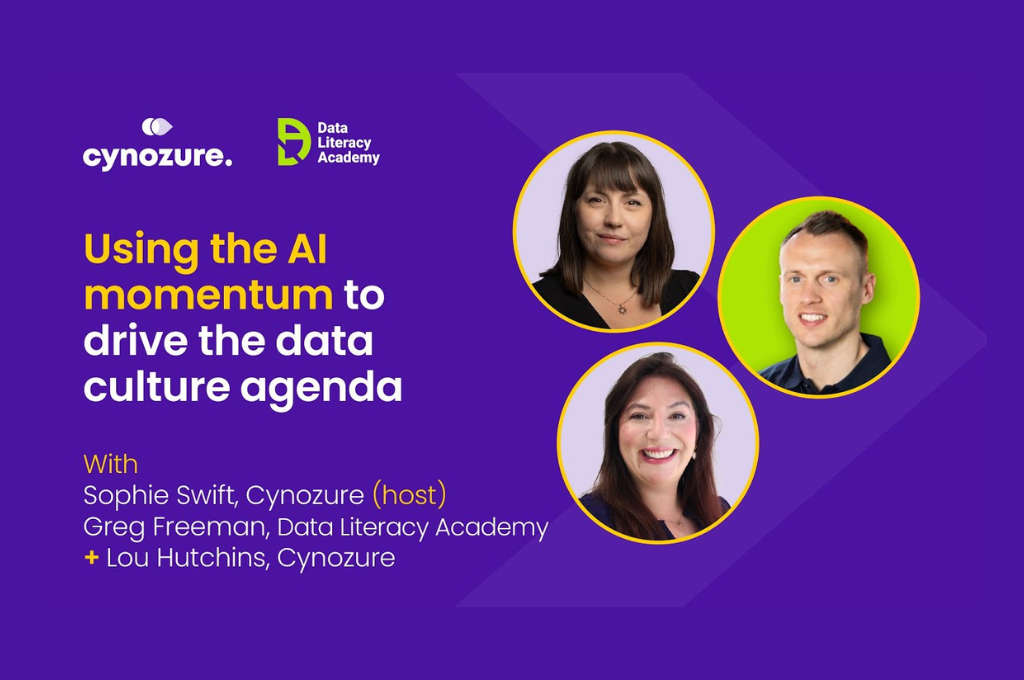AI is everywhere right now. It’s filling LinkedIn feeds, boardroom agendas, and dinner table debates.
For data leaders, that noise is more than a distraction. It’s a rare chance to reset the data conversation. The question is: will you ride the wave or watch it pass by?
Curiosity is the opening
Lou Hutchkins, Director of Data Culture and Literacy at Cynozure, put it plainly: “Everyone’s rushing into AI. But not everyone’s stopping to ask if their people are ready for it.”
That’s the danger. Leaders see AI as innovation, efficiency, cost savings. Yet behind every algorithm sits one simple truth: without the right data capability, AI will never reach its potential.
So yes, enjoy the hype. But don’t mistake curiosity for capability.
Greg Freeman, CEO of Data Literacy Academy, takes an even sharper line. “AI is the golden ticket,” he says. “It’s the best chance we’ve had in years to make data relevant again.” He’s right. Data, for many, has slipped into disillusionment. AI has captured the spotlight. And that gives data leaders a way back in.
But Greg also warns not to fall into the “AI theatre trap.” Flashy pilots and vanity projects might win you a round of applause, but they won’t change culture.
From hype to habit
Greg says this all the time, but it's worth repeating. People won’t use what they don’t understand. And they won’t trust what they don’t use.
He sums it up in three steps: understand → trust → use. Miss the first two and you’ll never reach the last. That’s why leaders matter so much. It’s not enough to sign off budgets or talk strategy. Leaders need to show, in their own decisions, how data and AI connect to business outcomes.
When leaders model confidence and curiosity, it sets the tone for the whole organisation.
One of the hardest truths Greg shared was this: “Most data offices only reach about 20% of their organisation. The rest? Silent. And that’s where the value is.”
It’s easy to get caught in the echo chamber, talking to the people who already care. But if you want cultural change, the silent 80% need to be engaged too.
That means thinking like a change manager, not a tech evangelist. Speak their language. Solve their problems. Show them why it matters to them, not just to the business.
Lou puts it bluntly: “If you’re not solving something real, you’re just adding noise.”
That could be saving frontline staff an hour a day. Or cutting the approval process from weeks to days. Or making customer experiences smoother.
When AI helps with things that matter, adoption follows. When it doesn’t, all you get is another shelfware project.
What success really looks like
Here’s what success isn’t: the number of people who attended a webinar. Or how many downloaded a slide deck.
Real success is when the business starts operating differently. When gut feel is replaced with data-led decisions. When AI frees up time for the human work that matters: building relationships, solving problems, innovating.
That’s when you know it’s sticking.
What happens to organisations that embrace both data and AI culture?
“They’ll be faster, more efficient, more competitive,” says Greg.
Lou takes it further: “They’ll be more adaptable. And adaptability is the multiplier. In a world changing this fast, it’s the edge every business needs.”
The takeaway
AI is your lever. Data is your foundation.
Use the hype to open the door, but build carefully. Start with understanding. Focus on real problems. Measure change by behaviour and outcomes, ditch the vanity metrics.
And remember: culture doesn’t shift with tech. It shifts with people.
Unlock the power of your data
Speak with us to learn how you can embed org-wide data literacy today.






.png)
.jpg)
.png)

.png)
.png)
.png)
.png)


.png)